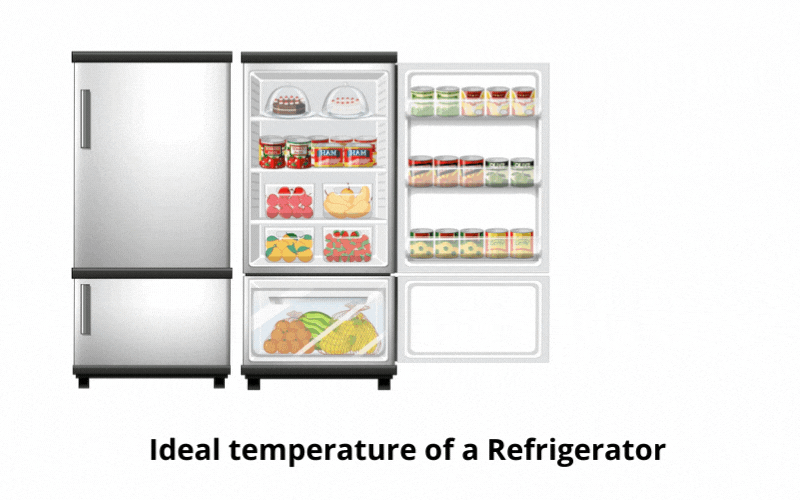Refrigerator's Ideal Temperature


The primary goal of investing in a refrigerator is to enhance the useful life of products stored in it or simply put, to keep the foods safe for longer. But the entire objective would become futile if the contents are not stored at the right temperature, as both too hot, and too cold temperatures can be inappropriate for a specific type of product.
But let us clarify what we are referring to as a refrigerator in this article. Refrigerators may include just the fridge portion, where the ice-making or, the freezer compartment is not included. However, the most commonly used appliances contain both the fridge and the freezer, or at least a small section to make and store ice and store products that need to be frozen.
Refrigerator Temperature and Technology
Now coming to the adequate temperature requirement in a refrigerator, we have to keep in mind that different sections of a refrigerator are designed to store different types of products, and also require different temperature settings. With the blessing of technology, refrigeration techniques have seen leaps and bounds of improvement. Modern refrigerators have modern temperature control systems which are not only advanced but also easily adjustable.
Importance of Maintaining Refrigerators Right Temperature
But why is it so important to maintain just the right temperature in your home appliance? Let us look at some key necessities of keeping the ideal temperature.
- The average temperature of the environment changes with each change of season. While in summer the food and perishables are at a greater risk of easily rotting, the same procedure is slowed during winter. The outside temperature often starts the bacteria growth early or aids in spreading it at a faster pace. Perishable items need to be refrigerated as soon as possible during hot and humid weather. So, an adequate temperature should be maintained within the refrigerator based on the overall environmental situation. Again, Cleaning regularly and maintaining the refrigerator will help in many cases.
- Moreover, different sorts of seasonal fruits and vegetables are also available around the year. These varieties of perishables require distinct care based on the calendar. Bananas and tomatoes wilt faster even in refrigerators while apples and berries last longer if left uncut or unopened. These fast-wilting items can ultimately spoil other contents in the refrigerator if not stored at the proper temperature.
- The quantity of items stored also affects the temperature requirement. Keeping a large number of cooked items in the refrigerator section, or storing a lot of raw meat and fish in the freezer will require a higher temperature. Moreover, storing lots of containers within the appliance, also tampers with the even cool air distribution throughout the compartments, especially for older models of refrigerators, meaning a lower temperature setting might be needed. The exact opposite situation takes place when the appliance is comparatively on the emptier side. Keeping food fresh at the proper temperature requires some easy tips and maintenance.
- Temperature requirement also differs based on the type of food you are storing in the refrigerators. While in the malls and departmental stores we see refrigerators catering to single sort of items such as soft drinks, dairy, ice cream, and other frozen snacks; the situation is a bit different in domestic circumstances. Household refrigerators hold a vast array of foods and condiments ranging from fresh produce to cooked meals to dairy. And hence it is of utmost importance to maintain a balanced temperature.
- The amount of time any item has been left under the normal temperature before refrigerating also matters as foods having a high temperature before refrigerating need more time to cool. Sometimes overstoring foods in the freezer also causes extreme dehydration, resulting in freezer burns, which do not necessarily spoil the food but deteriorate the taste to some extent.
What should be the Ideal Temperature of a Refrigerator?
So far, we have discussed the importance of maintaining an ideal temperature for your refrigerator. But what is the exact temperature that must be maintained? The adequate temperature depends on what is being stored, and hence the range differs for both the fridge and the freezer. These have also been discussed in this article as follows.
Ideal Temperature for Fridge
Your fridge must be chilly enough to stop bacterial growth, yet warm enough so that the food does not freeze. It is recommended that refrigerators be set to temperatures below 40°F (4°C). In general, a refrigerator should maintain a temperature between 34°F and 38°F (1°C to 3°C). Contents such as milk, other dairy products, eggs, and meat should be stored in the coldest areas. It is best to store produce, condiments, and other foods that can last longer in the warmer area of your refrigerator. Keeping the temperature between 34-38°F (1-3°C) will not kill bacteria or mold, but they do slow their growth.
Ideal Temperature for Freezer
The temperature in your freezer should never exceed 0°F (-18°C). Bacteria or mold may temporarily be inactivated by temperatures below zero degrees F, but they are not killed. The frozen food won't rot or multiply bacteria because it is not damaged. Almost all foods can be stored for a long time in the freezer. The freezer burn or quality loss may become apparent as frozen foods dry out with time.
You must nonetheless keep an eye out and continue to check if the temperature is adequate in your appliance from time to time.
Conclusion
A refrigerator is one of the most common and widely used kitchen appliances. It is a necessity for people. Refrigerator excels in the lifestyle of people with their usability and advanced features. House of Butterfly is the place where you can get a wide range f variety to choose the perfect one for your kitchen at the best price deal in Bangladesh.


Already Have An Account
Sign In To Track Your Order, Use Wishlist & More.